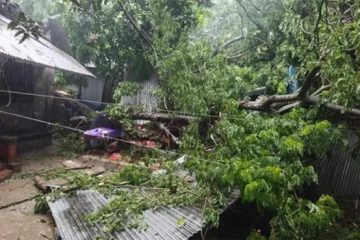 The country’s rivers have lost half of their navigability since independence, creating serious socio-economic and environmental impacts.
The country’s rivers have lost half of their navigability since independence, creating serious socio-economic and environmental impacts.
According to the latest statistics, the length of navigable waterways, which was about 14,000 km way back in 1964, now shrinks to 6,000 km during the rainy season and to 3,800 km in winter. Besides almost 80 per cent of the existing water routes are considered “risky”.
For a small country crisscrossed with rivers, water provides an ideal and cheaper mode of transport since construction of roads and railways requires both land and capital, said Dr Umme Kulsum Navera, associate professor in the Water Engineering Department of BUET.
The total length of the rivers of Bangladesh is about 24,000 km. The rivers discharge about five million cusecs of water during floods. Around 2.4 billion tonnes of silt is discharged annually through the rivers, which is 18.5 per cent of the total silt that accumulates in the world.
The rivers and the waterways are gradually shrinking and drying up because of the huge depositions of silt.
“Streamflow reduction, reduction in cross-boundary flow, silting up of off-takes and reduction of tidal volume are the main reasons behind drying up of rivers through deposition of silts,” Dr Navera said.
The loss of navigability has weakened the river communications system, vital for Bangladesh, and also undermined irrigation and pisciculture, raising the possibility of calamities such as floods.
Besides, it has also affected the capacity of rivers to drain out floodwater during monsoons, which has adversely impacted the economy, Dr Navera said.
“Low discharge in winter forms a system of channels in the rivers but the highrun-offs during monsoons destroy the system. Again when the floods recede and the water levels fall, the rivers are back with their characteristic channels and sandbanks. This never-ending process continues in cycles and is repeated year after year, ‘ he noted.
“The dual nature of a single river creates problems for navigation. Particularly in the low-water season, shoals and sandbanks surface in the channels creating obstacles to navigation,” said Abdul Matin, former chief engineer of Bangladesh Inland Water Transport Authority (BIWTA).
In most cases, shoals and sandbanks are removed through dredging to improve navigation, he said.
The BIWTA, the main agency responsible for dredging operations, is poorly equipped to do the job. It has recently taken up a Tk. 11,000-crore project to conduct dredging across the country, but experts say it would be a waste of money if it is not done in a sustainable manner.
“If dredging is conducted to improve navigation only on an immediate basis, it brings no good to the rivers or their navigation. There should be a proper analysis of the impact of dredging on the sustainability of the river,” Dr.Navera of BUET said.
“Suppose if you dredge the Jamuna to improve its navigation, within one year the situation might be reversed. So, here, river training is needed along with dredging to improve navigation. Otherwise, it would be a waste of money,” she pointed out.
BIWTA officials said that under the mega project, they would dredge 53 routes across the country. “This nine-year project will be implemented only to improve the navigability of those routes,” a top official of BIWTA said, adding that restoring the entire river network will require a dozen such projects.
Urging the authorities to take immediate steps to restore the navigability of the rivers, Dr Sabbir Mostafa Khan, another associate professor in the water engineering department of BUET, said the loss of navigation will have a serious impact on the bio-diversity and the echo system of the country.
For example, a fall in the water level would pave the way for the influx of saline water of the sea into the river system, which would bring catastrophe to the trees of the coastal land, particularly to the Sundarbans, he added.
The loss of navigability has a direct impact on the livelihoods of thousands of people engaged in river transport.
More than 50 per cent of the country’s economic activities are located within a distance of 10 km from the nearest navigable waterway in all seasons.
The topographic, soil and climatic conditions in Bangladesh are such that the cost of building and maintenance of roads and railways is very high compared to the maintenance of inland waterways, experts said.
They said that roads and railways destroy cultivable lands which, to the contrary,are sustained by the waterways.
However, shipping ministry officials claimed that the dredging is done under a comprehensive plan in order to maintain sustainability of the rivers by improving navigation through dredging.
According to the BIWTA, at least 400 launches have plied daily from the Barisal port to 78 regional routes in the last 10 years. The daily average has dwindled to 35 launches on eight routes. The river routes of Kirtonkhola, Arial Khan, Kalabadar, Shikarpur, Hizla, Naya Bhanguni, Sugandhaya and Meghna have developed shoals at various points, threatening traffic.
A large number of steamers, launches, cargo vessels and oil tankers ply the water routes every day to different destinations, including Dhaka,Narayanganj, Bhola, Patuakhali, Pirojpur, Madaripur, Barguna, Torki, Galachipa,Khapupara and Mehendiganj.
A BIWTA official said massive depositions of silt threatens the existence of the river Brahmaputra. The 2,947-km-long river, streaming through Dibrugarh, Guwahati and Meghalaya of India, enter Bangladesh from the western side of the Garo Hills.
It flows through Dewanganj, Nalitabari, Jamalpur town and Mymensingh and meets with the Meghna river near Bhairab Bazar in Kishoreganj district.
The mighty river is gradually turning into a canal.
Sources said the Dhaka-Chittagong, Choukighata-Barisal and Khulna-Mongla routes have become risky as shoals have surfaced at different channels, including Hatiya,Swandeep, Kirtonkhola, Gabkhan, Boleshwar, Pashur, Meghna and Bhairab.
Besides, the navigability of the rivers Padma, Meghna, Jamuna, Arialkha, Bhadra,Karnafuli, Dhaleshari, Buriganga, Shitalakhya, Turag, Balu, Madhumoti, Ishamoti, Bhairab, Lohalia, Kabodak, Dakatia, Korotoa, Kushiara, Kushiara and Surma are also in jeopardy.
Courtesy of The Independent




















